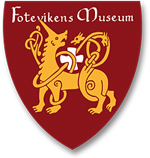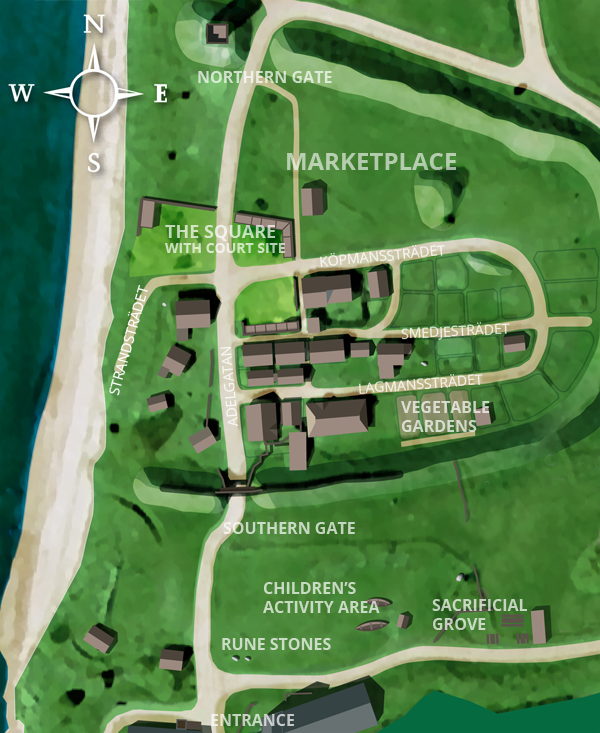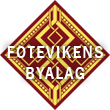Map of the Viking town
The Viking Town of Foteviken is created in order to illustrate what a densely built-up settlement might have looked like during the late Viking Age and early Middle age. This area is being developed gradually and it will look more and more like a little early medieval city.
Semicircular defence earthworks enclose the conurbation. The wall opens toward the beach of Höllviken to the west. In the north and south there are two town gates, with the main street of the town running between them. From this, smaller streets lead down to the structures east of the main road. Buildings of various dimensions and styles crowd the area. In front of the town hall there's an open square for gathering.
â–ş Download map of the museum area as a PDF document
â–ş Karte von Fotevikens Museum auf Deutsch als PDF dokument herunterladen
Outside the town wall
In this area just outside the town wall you will find simple handicraft houses.
1. The pit house
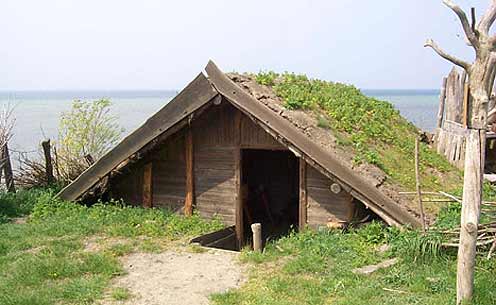
Pithouses were common during the Viking Age. The house has a length of 5 meters and a width of 4 meters. Half of the house is situated under the ground level. The archaeologists often discover weights, made out of clay in the pit houses. These weights belonged to the upright Viking Age looms. This indicates that the pit houses were used as handicraft workshops. Hearths are not common in the pit houses and it is therefore likely that the houses were used only during the warmer season. The houses were perhaps used for storage during the winter.
Inside this pit house there is a long bench fixed to the wall. This was probably used as a bed or for sitting in during work. Fragments of such long benches have been found in the Parish of Fosie, near the City of Malmoe. This kind of bench was made of earth and wood. They were constructed with earth filling material and there was a wooden framework on the side.
2. The poultry house
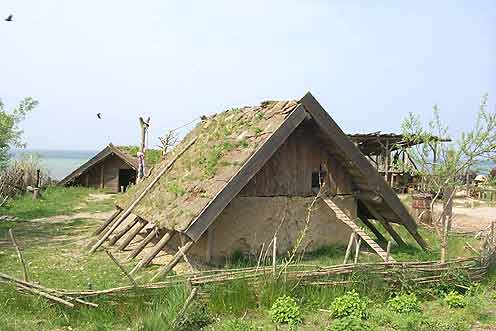
All our animals need tending and care. This is a simple house built in Wattle and Daub technique with a turf roof. The roof rafters reach all the way down into the ground, a typical Viking Age construction. It was built for our poultry and it was one of the first houses to be built at the museum. The Vikings need the eggs for cooking the old traditional food of Scania.
West of the road
Inside the southern gate, west of the road along the coast you will find the Tanner's homestead with the small smokehouse and fishery cottage. Further north the watch tower looms over the northern gate.
3a. Tanner's homestead: residence
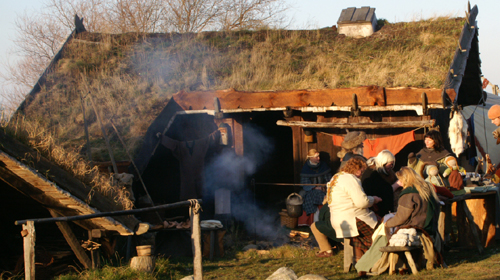
This is a Stave wall house built of solid oak. The walls are constructed with double stave planks. The original was discovered at the archaeological excavations of the Viking Age City of Haithabu, in Schleswig, in Germany. The original house probably had some kind of tightening material between the stave planks. The tightening material used here at Foteviken, is grass-wrack, a kind of seaweed, which is very common around the coast of Scania. The grass-wrack does not rot, contrary to straw.
At the Tanner´s farm everything regarding hunting and fishing is dealt with, including handcrafted leather, bone and horn items.
3b. Tanner homestead: Fishery cottage
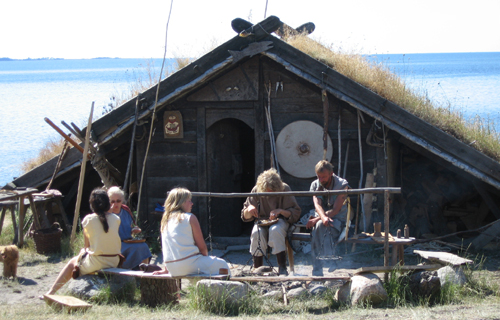
This is a small wooden house and the original is depicted on some rock-carvings. The small cottage is built in Thatched country technique and Wattle and Daub technique. The roof reaches almost to the ground and forms together with the inner and outer walls extra space for storage around the cottage. The hearth on the stone floor and the benches, fixed to the wall create a genuine Viking Age atmosphere.
3c. Tanner's homestead: Smokehouse
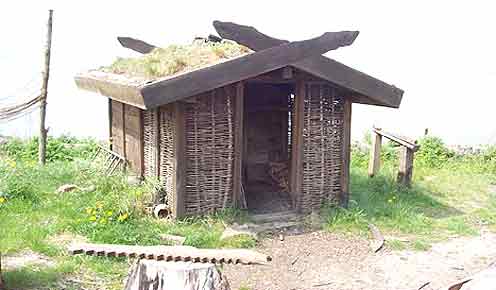
Inside the inner timbered room, the fish or meat is hanging, while the smoke rises from the heath on the floor at the correct temperature. It takes about three hours for the fish to be ready and about six hours for the meat. Before the smoking starts the fish or meat is hung up for drying in the little outer room. The wattle walls supply the perfect climate for this procedure. The drying is very important in order to prevent the fish from becoming too soft and fall down from the smoke hooks during the smoke-curing.
4. Watch tower
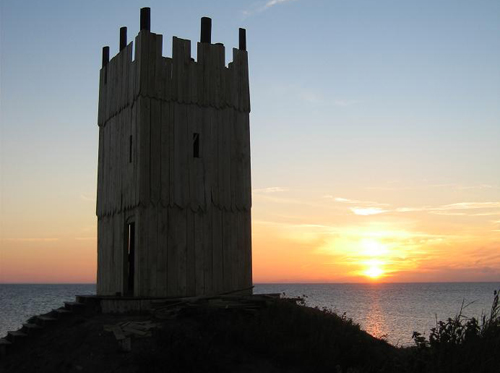
The Watch Tower, on it´s elevated location, by the northern town gate, serves several purposes. The view allows an excellent lookout for incoming dangers both from the sea and land. It also allows the town authorities to keep track of travelers by land and sea, ensuring that tolls and taxes are paid, and to get an overview of what transpires within the town.
The city's weapons and treasurechest is stored in the tower.
East of the road
Narrow roads runs from the main road into the settlement. When entering the little city via The South gate, you will find the Lawman's house to the right with the great hall Tinghöll just beyond. The weaver's house is also located by this road, with the baker's homestead behind it. Further along another road runs from the main street to the merchant's estate and the willow homestead. Fences and ditches separate the different sites. There are small footbridges across the ditches.
5a. The Lawman's House
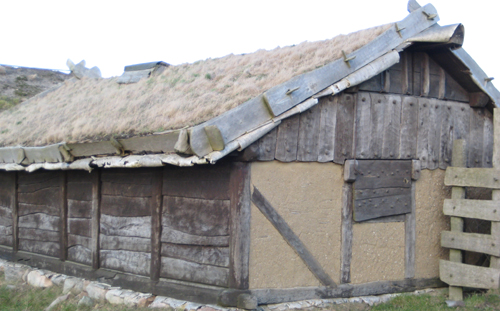
"A country must be built up by law." These magnificent words were spoken by the Danish King Valdemar the Victorious in 1241. The Viking Town of Foteviken has of course its own Lawman. The Lawman dwells in a magnificent house of his own. There are two rooms in this house and some guests may stay the night if the Lawman is generous enough. Couples getting married at Foteviken, in Tinghöll, may of course use the house as a bridal suite during their wedding night. The long sides are built in Thatched Country technique and the gables are built in Wattle and Daub technique.
5b. Glass beads and amber workshop
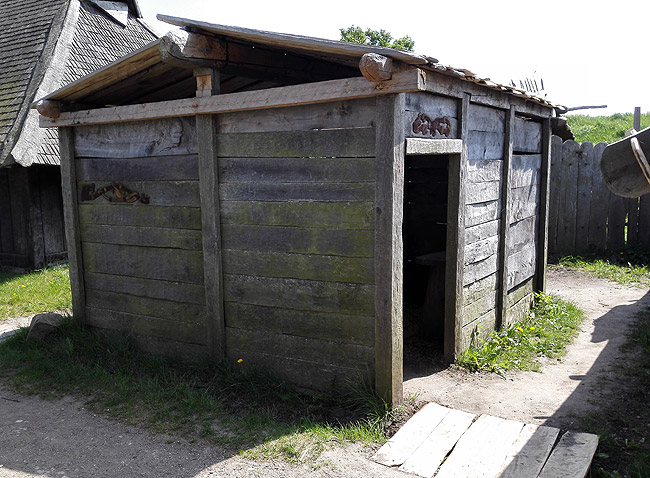
Simple workshop in connection to the Lawman's house for producing glass pearls and amber working.
6. Townhall (Tinghöll)
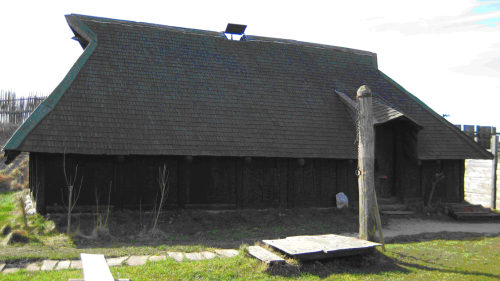
Tinghöll is the great town hall, located in the center of the town and a place for congregation and festivities at Foteviken. The construction technique is based on that of Norwegian stave churches and descriptions in Icelandic written sources.
Tinghöll has three naves with two doors. Along the sides there are multiple windows. The windows and the three roof hatches serves as ventilation and contributes with fresh air and transports the smoke out.
At Tinghöll you might meet vikings playing Hnefatafl, telling stories and sagas from past times.
7. The weaver's house
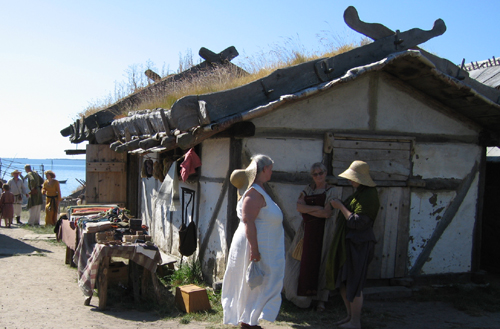
The house is built in Wattle and Daub technique. These kinds of houses were probably typical for the late Viking Age cities. Inside the house there is a smoke-oven keeping the house nice and warm, even during the coldest winter nights.
Everything regarding textiles is managed at the Weaver's House. Here they needle bind, spin and prepare the yarn but also it's where fabric is woven and clothes are sewn.
8a. Baker's homestead: residence
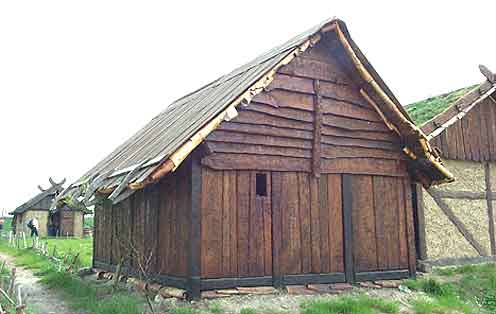
The originals of this beautiful house were found at archaeological excavations in the City of Lund, in Scania. The original house date back to the mid 11th century. These kind of houses are called Stave Wall houses. There are thick oak uprights firmly secured in the ground, supporting the house. The stave planks are attached to the bottom sill. The overhanging anchor beams are decorated with carved dragon heads, one of the favorite symbols of the Vikings.
8b. Baker's homestead: Storage House
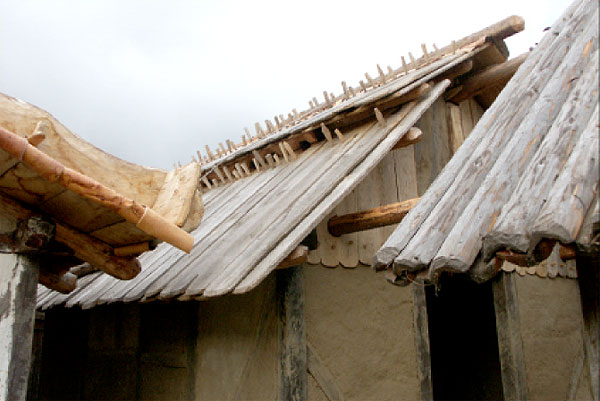
The Storage House is separated from the Bakers home by a small gap. This building is constructed as a half timbered house with Wattle and Daub walls, a fairly typical design for the Scanian plains. This type of building dates back to the Bronze Age and is an indication of a construction technique used when there was a shortage of timber. The roof of the Storage House is made with special lengthwise beams with large holes. The wooden roof is in this way split into an upper and a lower roof section, based on a find in Lund. This construction has several advantages. Instead of long, likely expensive wooden planks, shorter construction material could be used. The holes let in light and serve as air and smoke holes.
8c. Baker's homestead: The bakery
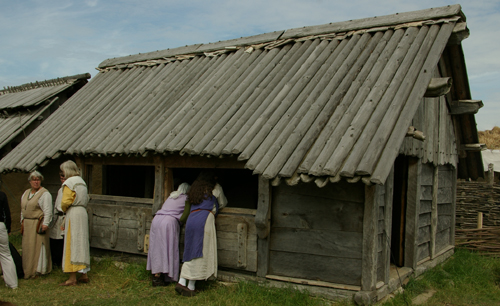
How a bakery would have looked during the Viking Age is unknown but the tales often mention such buildings.The building would obviously have held both a fireplace and an oven. The building is constructed in thatched country style with horizontal planks between posts. The roof is made of cleaved round timber. The disadvantage of this design is keeping it tight. If you hollow out a split round timber log however it may be used in the same manner as medieval roof tiles with monk and nun tiles - two logs covering each other. To test this method the bakery was constructed using this roof design. The result is excellent. The smoke can easily pass through the ceiling while rain water is kept from leaking in.
In the center of the bakery is a large Daub bakery oven. The bottom foundation of several such ovens have been found, among them one in Malmö from the mid 13th century.
In the bakery grain is turned into flour and used to bake different kinds of bread that is often served with honey. Here is also where the butter is churned and the cheese is made.
8d. Baker's homestead: cooking shed
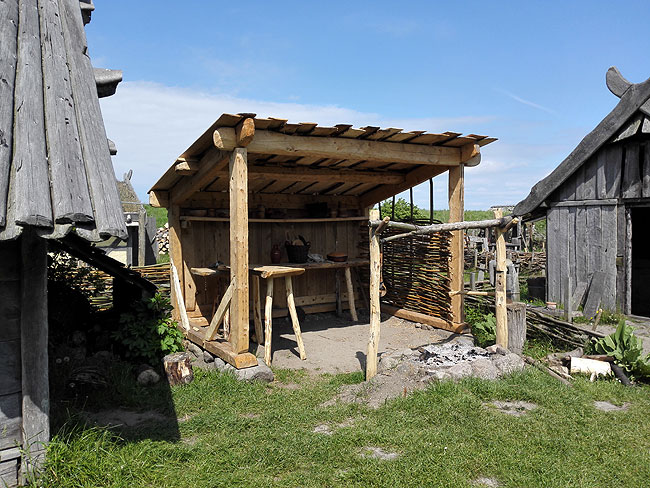
The cooking shed is the latest addition to the Baker estate, located just past the bakery.
9. The merchant's estate
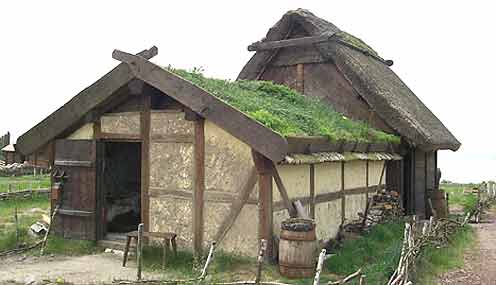
This is a South-Geatish house. It is two houses built together, a dwelling house and a barn with an attic. The dwelling house is built in Wattle and Daub technique and the barn or farm building is a Thatched country cottage. There is a smoke-oven, a wooden floor of oak and elegant furniture. The Tapestry of Foteviken, depicting The Battle of Foteviken in 1134, is hanging on the wall. The poor-man's beam is there too. This beam marked the border of the privacy of the home.
The Merchant Estate is run by the woodcarver. Here the citizens can borrow or buy containers, chests, tools and different kinds of wood items.
10. The Blacksmith's workshop

This house was built in Wattle and Daub technique and with a timbered roof. The house has two rooms, the workshop and a little dwelling room for the blacksmith. Next to this house there is also a little blast-furnace for making iron.
Different kinds of iron products are made at the Blacksmith's Workshop, for example nails, firesteel, swords, knife blades and arrowheads. This is also the place to go when you have a toothache
11. The Willow Estate
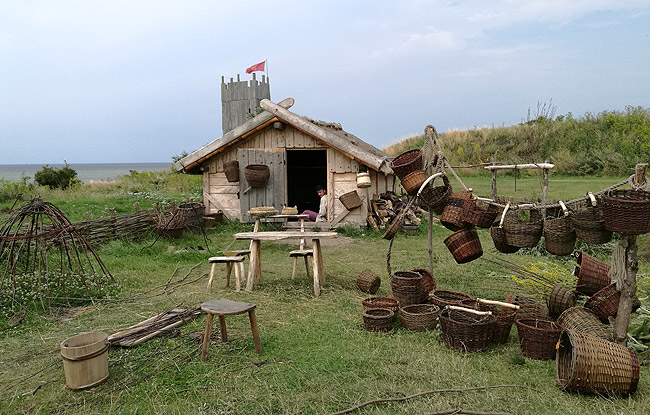
The Willow Estate is a Tral house. The house is decorated with clay-colored walls in a perforated frame of oak and has a roof with peat. Simple and robust.
The Willow Estate is a part of the Weaver's House. The care and attention needed by the flax plant to become linen fibers is performed here. The estate is also a place for dying fabric, washing clothes with lye and homemade soap and braiding basket from willow.
12. The toll shed
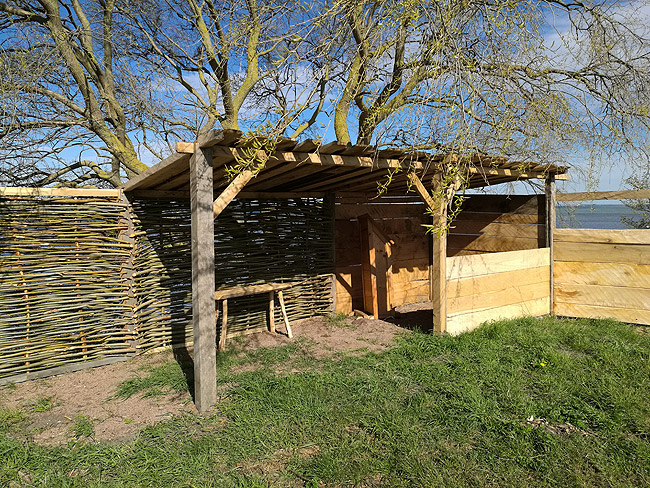
The Toll shed was built in the spring of 2017 and is a simple shed with partially braided walls. Here the town receives its customs fee duty from travelers arriving by sea.
Here is where the monk resonates. He makes sure everyone pays their taxes and ensures that incoming travelers are being honest and follow the rules of the city. He controls that everyone uses the right measurements and weights.
